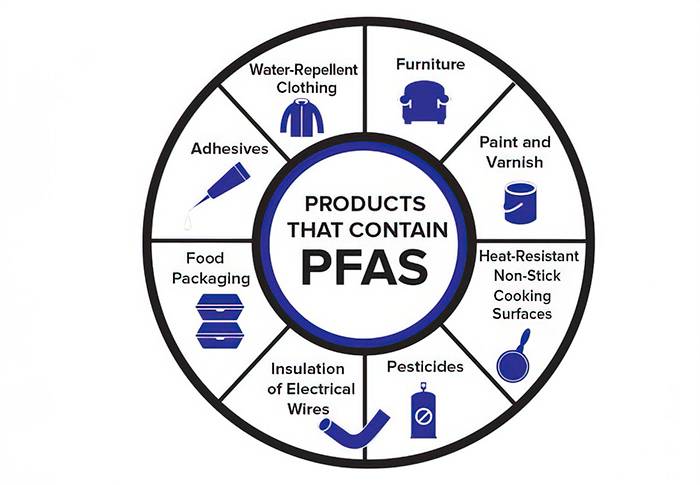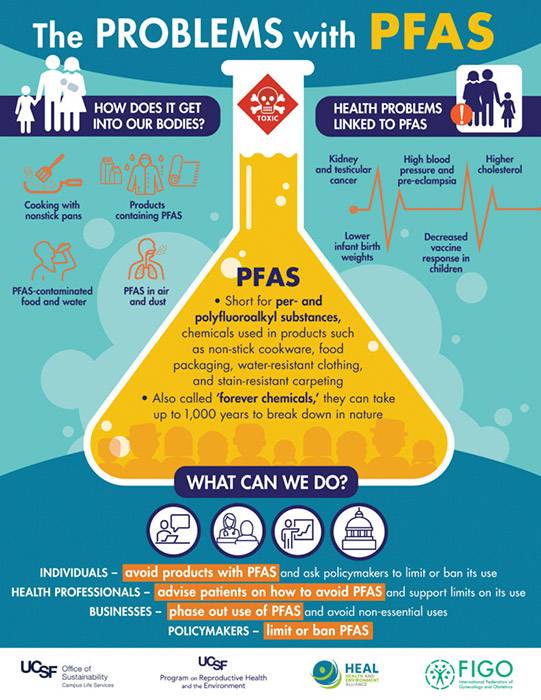Beautiful Plants For Your Interior

What is PFAS – The Invisible Contaminants in Our Everyday Lives
What is PFAS? Imagine an invisible threat lurking in your everyday life, a group of chemicals that have infiltrated your food, water, and even the air you breathe. These chemicals, known as PFAS, PFAS stands for per- and polyfluoroalkyl substances.
What is PFAS: The Forever Chemicals
PFAS is a group of over 4,700 man-made synthetic chemicals that have been used in a wide variety of products since the 1940s. They are known for their unique properties that make them water and oil-resistant, stain-resistant, and non-stick. PFAS have a unique molecular structure that makes them highly resistant to breakdown.
Their widespread use in various products, from non-stick cookware to firefighting foam, has led to their widespread presence in our environment, raising serious concerns about their potential health impacts.
PFAS have been dubbed “forever chemicals” due to their persistence in the environment. They can travel long distances through air and water, accumulating in soil, plants, and animals, including humans. This widespread contamination has resulted in the exposure of millions of people worldwide, raising concerns about the potential long-term health effects of these chemicals.

What is PFAS: Many Products Contain PFAS The ‘Forever Chemicals’
Scientific studies have linked PFAS exposure to a range of health problems, including cancer, thyroid disorders, reproductive issues, and immune system dysfunction. These chemicals have been shown to interfere with hormones, disrupt development, and increase the risk of certain cancers. The growing body of evidence on the health hazards of PFAS has fueled concerns about their widespread use and prompted calls for stricter regulation and safer alternatives.
As we continue to uncover the potential health risks of PFAS, it is crucial to take steps to reduce our exposure to these chemicals. By making informed choices about the products we use and advocating for cleaner alternatives, we can protect ourselves and future generations from the potential harm of PFAS contamination by choosing products that are labelled as PFAS-free
What Are PFAS? Things You Need to Know About
1. PFAS Are a Group of Man-Made Chemicals That Are Found in a Wide Variety of Products, Including:
- Non-Stick Cookware
- Stain-Resistant Fabrics
- Firefighting Foam
- Food Packaging
- Personal Care Products
2. PFAS Are Persistent in The Environment
- PFAS are very stable and do not break down easily in the environment. This means that they can persist in the environment for years or even decades.
- PFAS can also bioaccumulate in humans and animals. This means that they can build up in the body over time.
3. There is Growing Evidence That PFAS Exposure Can Lead to Several Health Problems. These include:
4. There is no Safe Level of Exposure to PFAS.
- Because PFAS are persistent and can bioaccumulate, there is no safe level of exposure to these chemicals. Even low levels of exposure can be harmful to health.
5. There Are Some Things That You Can do to Reduce Your Exposure to PFAS, Including:
- Choosing products that are PFAS-free
- Avoiding consuming contaminated fish and water
- Using a water filter that removes PFAS
It is important to note that research on PFAS is ongoing, and scientists are still learning about the full extent of their health effects. However, the evidence to date suggests that PFAS are a serious threat to public health. We all need to take steps to reduce our exposure to these chemicals and to develop safer alternatives.

What is PFAS: The Problems And What We Can Do
What is PFAS?: The Unique Properties of PFAS in Various Applications
Water and Oil Resistance: Sorry for the technical jargon but… PFAS molecules are surrounded by a shell of fluorine atoms, which gives them a strong electronegative charge. This electronegative charge repels water and oil molecules, making PFAS materials water and oil-resistant. This property is useful in a variety of applications we use daily, such as non-stick cookware, stain-resistant fabrics, and water-resistant coatings.
Low Surface Tension: PFAS molecules have a low surface tension, which means that they spread out easily on surfaces. This property is useful in a variety of applications, such as surfactants, which are used to lower the surface tension of water and make it easier for it to spread out. Surfactants are used in a variety of our everyday products, such as detergents, shampoos, and emulsifiers.
Heat Resistance: PFAS molecules are very stable and can withstand high temperatures without breaking down. This property is useful in a variety of applications used each day, such as non-stick cookware, high-performance lubricants, and heat-resistant coatings.
There are many different types of PFAS, but some of the most common include:
- Perfluorooctanoic acid (PFOA): PFOA was used in the manufacturing of Teflon, a non-stick coating for cookware. It was also used in other products, such as carpets, upholstery, and stain-resistant fabrics.
- Perfluorooctane sulfonic acid (PFOS): PFOS was used in the manufacturing of Scotchgard, a stain-resistant treatment for fabrics and carpets. It was also used in other products, such as firefighting foam and paints
- Perfluorohexanoic acid (PFHxA): PFHxA is used in the manufacturing of fluorinated polymers, which are used in a variety of products, such as electronics and packaging.
- Perfluorononanoic acid (PFNA): PFNA is used in the manufacturing of surfactants, which are used in detergents, shampoos, and other cleaning products.
The following table summarises the common uses of some of the most common PFAS:
| PFAS | Common Uses |
|---|---|
| PFOA | Non-stick cookware, stain-resistant fabrics, carpets, upholstery |
| PFOS | Stain-resistant fabrics, carpets, firefighting foam, paints |
| PFHxA | Fluorinated polymers, electronics, packaging |
| PFNA | Surfactants, detergents, shampoos, cleaning products |
It is important to note that this is not an exhaustive list of PFAS and their common uses. Many other types of PFAS are used in a variety of other products, especially in our own houses and homes. You can download an exhaustive UK government report which will provide further detailed information about PFAS.
As a result of their widespread use, PFAS are found in a wide range of environmental samples, including air, water, soil, and food. They can also be found in the blood of humans and animals.
Protecting Yourself from PFAS Exposure
Reducing your exposure to PFAS requires a proactive approach to your daily choices and habits. Here are some practical tips to minimise PFAS exposure:
- Read labels carefully and choose PFAS-free products whenever possible. Look for products that are specifically labelled as “PFAS-free” or “PFOA-free” and “PFOS-free” when making purchases. This includes PFAS Free cookware, food packaging, personal care products, and stain-resistant fabrics.
- Minimise consumption of fast food and pre-packaged meals. Fast food and pre-packaged meals often use PFAS-containing packaging materials, leading to potential exposure. Opt for fresh, home-cooked meals whenever possible to reduce your intake.
- Filter your drinking water. Install a water filtration system certified to remove PFAS from your drinking water. This can significantly reduce your exposure to these chemicals.
- Avoid using non-stick cookware when possible. While convenient, non-stick cookware often contains PFAS coatings. Opt for PFAS free non-stick cookware, or stainless steel, cast iron, or glass cookware.
- Limit the use of stain-resistant products. Stain-resistant fabrics, carpets, and upholstery often contain PFAS treatments. If possible, choose untreated options or consider using natural stain removers.
- Wash fruits and vegetables thoroughly. PFAS can contaminate fruits and vegetables through contaminated water or soil. Wash produce thoroughly under running water to remove any potential surface contaminants.
- Choose fresh meat, fish, and dairy products. Packaged meat, fish, and dairy products may have been exposed to PFAS during processing or packaging. Opt for fresh options whenever possible.
- Avoid using microwave popcorn bags. Microwave popcorn bags often contain PFAS that can transfer to the popcorn during cooking. Choose air-popped popcorn or microwave popcorn kernels in PFAS-free packaging.
- Clean your kitchen and home regularly. Regularly wipe down surfaces with a damp cloth to remove PFAS that may accumulate from dust, food residue, or other sources.
- Stay informed about PFAS contamination issues in your area. Be aware of local water contamination reports and consider testing your water if concerns arise. Stay updated on new research and developments regarding PFAS exposure and mitigation strategies.
FAQ’s
How Do I Test My Drinking Water For PFAS in The UK
In the UK, testing drinking water for PFAS can be conducted by specialised laboratories using techniques such as LC-MS-MS (source: Eurofins UK). Water companies also must ensure water is wholesome, and there are ongoing discussions about the need for statutory standards for PFAS in drinking water in England and Wales (source: Drinking Water Inspectorate).
Should I Throw Away My Old PFAS Teflon Cookware
That’s very much an individual choice. From an environmental standpoint, we don’t want to encourage waste, but non-stick pans may make up part of your PFAS exposure, especially when the coating is old and flaking.
When it does come time to replace your cookware, then we’d recommend ensuring you buy PFAS free, and we have information on our website gardenjunkie.co.uk that can help you with that.
Conclusion
What is PFAS? Now you have a better idea. As you can see PFAS chemicals are a serious threat to our health and environment. We need to take steps to reduce our exposure to these chemicals and develop safer alternatives. By taking action together, we can protect our health and the environment for future generations.
Remember, every action you take to reduce your PFAS exposure makes a difference. Together, we can create a healthier world for everyone.
Disclaimer: The contents of this article are for educational purposes only. Please consult a physician, or other suitable professionals for advice.
